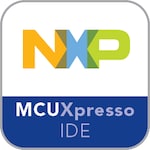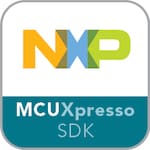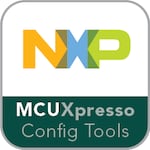Getting Started with the FRDM-MCXE247 Board
Contents of this document
-
Out of the Box
-
Get Software
-
Build, Run
-
Create
-
MCUXpresso Developer Experience
Sign in to save your progress. Don't have an account? Create one.

Purchase your FRDM-MCXE247 | MCUXpresso Developer Experience
1. Out of the Box
Let's take your FRDM board for a test drive! You have the choice of watching the sequence in a short video or following the detailed actions listed below.
1.1 Get Familiar with the Board
The FRDM-MCXE247 board is pre-programmed with a LED blinky demo. This serves as a sanity check to verify that the device is working as expected out of the box.

1.2 Plug In the Board
Connect a type-C USB cable from connector J13 to a host computer or power supply to power up the board and run the demo program. At this point, you should see the RGB LED blinking at a steady rhythm.

2. Get Software
2.1 Install Your Toolchain
NXP offers a complimentary toolchain called MCUXpresso IDE. Please download MCUXpresso v11.8.1 or above.

Learn how to install VS Code for your host PC with the following tutorial.
Want to use a different toolchain?
If you need help choosing, explore the MCUXpresso Suite of Software and Tools.
The MCUXpresso SDK includes support for other tools such as IAR , KEIL and command-line GCC .
2.2 Jump Start Your Design with the MCUXpresso SDK
The MCUXpresso SDK is complimentary and includes full source code under a permissive open source license for all hardware abstraction and peripheral driver software. You may install the MCUXpresso SDK directly form the MCUXpresso SDK website . Click the button below to open this board's SDK builder.

2.3 MCUXpresso Config Tools
The MCUXpresso Config Tool is an integrated suite of configuration tools that guides users in creating MCUXpresso SDK projects, and also provides pin and clock tools to generate initialization C code for custom board support. It is fully integrated as a part of MCUXpresso IDE and also as a separate tool if using a different IDE.
Click the Get MCUXpresso Config Tools below to get the Config Tools installer.

2.4 Programming and Provisioning Tools
NXP provides MCUXpresso Secure Provisioning (SEC) for trial run and mass production use. It supports secure programming and device provisioning on NXP's microcontrollers at the production stage. The MCUXpresso Secure Provisioning (SEC) Tool is a GUI-based application provided to simplify the generation and provisioning of bootable executables on NXP MCU devices.
The Secure Provisioning SDK (SPSDK) is an open source development kit with its source code released on GitHub and PyPI . This command-line tool is useful when interfacing with a custom or partner programming tool.

3. Build, Run
If one or more of the demo applications or driver examples sounds interesting, you're probably wanting to know how you can build and debug yourself. The Getting Started with MCUXpresso SDK guide provides easy, step-by-step instructions on how to configure, build and debug demos for all toolchains supported by the SDK.
3.1 Build and Flash Application using MCUXpresso IDE
The following steps will guide you through the hello_world demo application using MCUXpresso IDE for the Cortex-M33 application. The MCUXpresso IDE installation and the SDK for the MCX E-Series can be found at the section Get Software of this getting started guide.
- Find the Quickstart Panel in the lower left-hand corner
- Then click on Import SDK example(s)
- Click on the FRDM-MCXE247 board to select an example that can run on that board, and then click on Next
- Use the arrow button to expand the demo_apps category, and then click the checkbox next to hello_world to select that project. To use the UART for printing (instead of the default semihosting), select UART as the SDK Debug Console checkbox under the project options. Then, click on Finish
- Select the project and build it by either clicking on the “build icon” in the shortcuts provided above or by clicking “Build” in the Quickstart Panel
- The project should build without presenting any errors or warnings in the console
- Connect the board to your computer with the micro USB to
J13‘MCU-LINK’ port - Download the application to your board by either clicking on the “debug” icon above or clicking on “Debug” in the Quickstart Panel
- Select the MCU-Link CMSIS-DAP debug probe
- Open up a serial terminal to be able to see the application’s output. Select the “Terminal” window and press the “new terminal” icon
- Choose a “Serial Terminal” and then set the UART settings to 115200 baud rate, 8-bit data size, no parity and 1 stop bit. Press OK
- Run the application by pressing the “run” icon. See the output printed on the terminal











3.2 Build and Flash Application with Alternative Toolchains
MCUXpresso for Visual Studio Code (VS Code) provides an optimized embedded developer experience for code editing and development. Learn how to build and flash an application with VS Code.
Using a different toolchain?
This demo is also available for IAR and KEIL.
4. Create
4.1 Clone an Example Project from MCUXpresso IDE
The following steps will guide you through the manipulation of the general-purpose outputs. The example sets up a FTM to generate a PWM signal and make red LED blink.
- Find the Quickstart Panel in the lower left-hand corner and click on Import SDK example(s)
- Click on the FRDM-MCXE247 board to select that you want to import an example that can run on that board, and then click on Next
- Use the arrow button to expand the driver_examples category, then expand the ftm examples, click on the check box next to ftm_simple_pwm to select it. To use the UART for printing (instead of the default semihosting), Select UART as the SDK Debug Console checkbox under the project options. Then, click on Finish
- Click on the
frdmmcxe247_ftm_simple_pwmproject in the Project Explorer View and build, compile, and run the demo as described in the previous section - You should see the red LED blinking at a steady rhythm
- Terminate the debug session




4.2 Use MCUXpresso IDE Pins Tools
- Open the pins tool by selecting “ConfigTools” on the top-right hand of the file explorer window and then select “Open Pins”
- The pins tool should now display the pin configuration for the FTM project

5. MCUXpresso Developer Experience
Check out each of the following sections, to learn about the ecosystem provided for flexible prototyping and development. In the video below, we will introduce you to the FRDM platform, the full-featured EVK and the compatible shields for extended capabilities. In addition we will walk you through our Application Code Hub portal where we provide numerous application examples through NXP's GitHub .
5.1 FRDM Platform, Full feature EVK and Shields
For quick prototyping platforms, we offer both the low-cost FRDM platform and the full-featured EVK.
FRDM Development Boards come with standard form factor and headers, easy access to MCU I/Os, onboard MCU-Link debugger and a USB-C cable. Our full features evaluation kits include extended I/O and interface access, extendable with WiFi and additional MCU-Link features. There are also many compatible Click Board and/or Arduino shields. For those that are supported with an Open CMSIS Pack example may be available on ACH, but if not many of them are easy to use via serial interface like I²C, SPI and UART, for which we provide drivers with examples in the MCUXpresso SDK.
5.2 Application Code Hub
The Application Code Hub further enhances our MCUXpresso Developer Experience by giving developers an interactive dashboard to quickly locate software. Visit the ACH today to start exploring or discover additional details and benefits of the new interactive Application Code Hub.
Software accessible from Application Code Hub is located in NXP’s GitHub repository so it can be easily accessed and cloned from that location directly.
5.3 Demo Walkthrough
The Application Code Hub further enhances our MCUXpresso Developer Experience by giving developers an interactive dashboard to quickly locate software. Visit the ACH today to start exploring or discover additional details and benefits of the new interactive Application Code Hub.
Software accessible from Application Code Hub is located in NXP’s GitHub repository so it can be easily accessed and cloned from that location directly.
Design Resources
Board Documents
Additional References
In addition to our FRDM Development Board for MCX E245/246/247 MCUs page, you may also want to visit:
